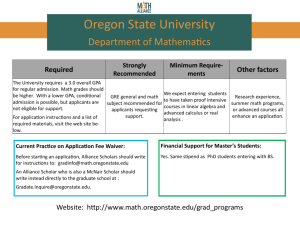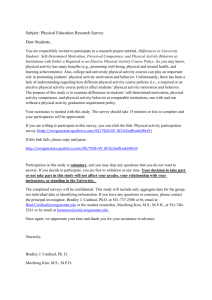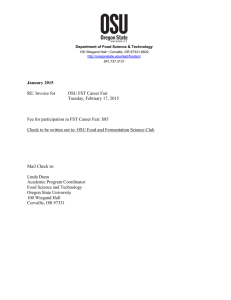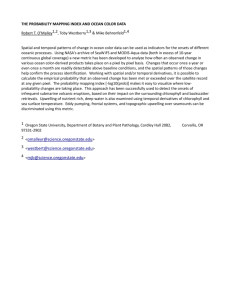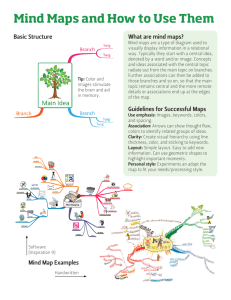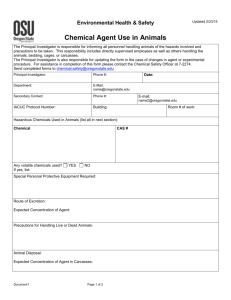strategic intent – international
advertisement
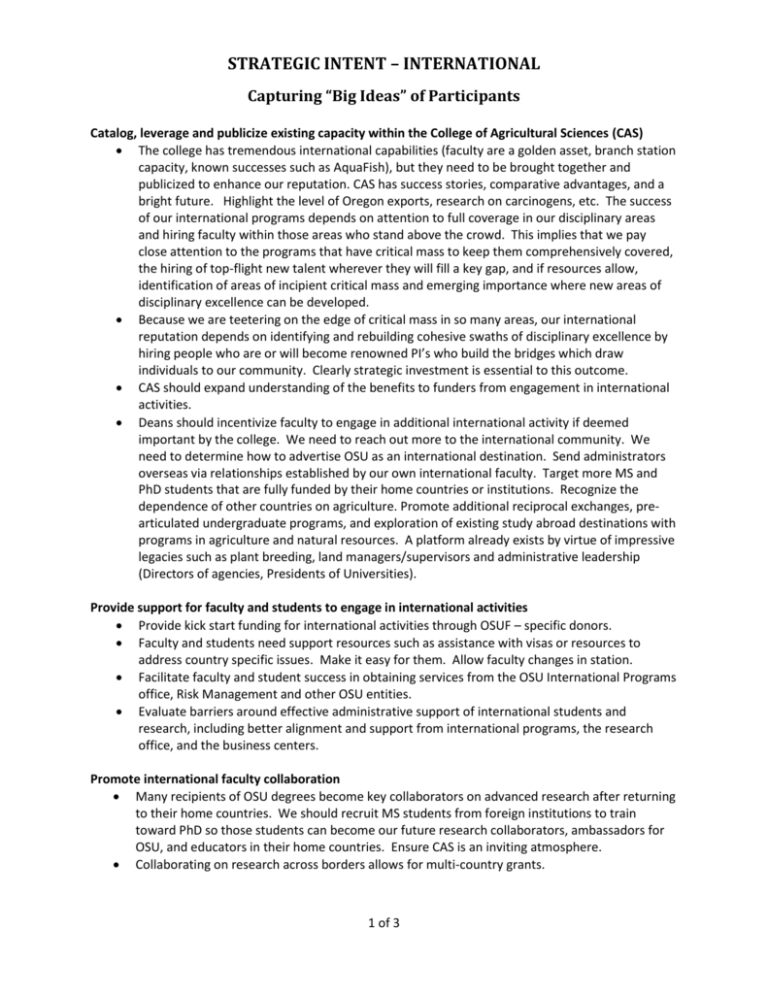
STRATEGIC INTENT – INTERNATIONAL Capturing “Big Ideas” of Participants Catalog, leverage and publicize existing capacity within the College of Agricultural Sciences (CAS) The college has tremendous international capabilities (faculty are a golden asset, branch station capacity, known successes such as AquaFish), but they need to be brought together and publicized to enhance our reputation. CAS has success stories, comparative advantages, and a bright future. Highlight the level of Oregon exports, research on carcinogens, etc. The success of our international programs depends on attention to full coverage in our disciplinary areas and hiring faculty within those areas who stand above the crowd. This implies that we pay close attention to the programs that have critical mass to keep them comprehensively covered, the hiring of top-flight new talent wherever they will fill a key gap, and if resources allow, identification of areas of incipient critical mass and emerging importance where new areas of disciplinary excellence can be developed. Because we are teetering on the edge of critical mass in so many areas, our international reputation depends on identifying and rebuilding cohesive swaths of disciplinary excellence by hiring people who are or will become renowned PI’s who build the bridges which draw individuals to our community. Clearly strategic investment is essential to this outcome. CAS should expand understanding of the benefits to funders from engagement in international activities. Deans should incentivize faculty to engage in additional international activity if deemed important by the college. We need to reach out more to the international community. We need to determine how to advertise OSU as an international destination. Send administrators overseas via relationships established by our own international faculty. Target more MS and PhD students that are fully funded by their home countries or institutions. Recognize the dependence of other countries on agriculture. Promote additional reciprocal exchanges, prearticulated undergraduate programs, and exploration of existing study abroad destinations with programs in agriculture and natural resources. A platform already exists by virtue of impressive legacies such as plant breeding, land managers/supervisors and administrative leadership (Directors of agencies, Presidents of Universities). Provide support for faculty and students to engage in international activities Provide kick start funding for international activities through OSUF – specific donors. Faculty and students need support resources such as assistance with visas or resources to address country specific issues. Make it easy for them. Allow faculty changes in station. Facilitate faculty and student success in obtaining services from the OSU International Programs office, Risk Management and other OSU entities. Evaluate barriers around effective administrative support of international students and research, including better alignment and support from international programs, the research office, and the business centers. Promote international faculty collaboration Many recipients of OSU degrees become key collaborators on advanced research after returning to their home countries. We should recruit MS students from foreign institutions to train toward PhD so those students can become our future research collaborators, ambassadors for OSU, and educators in their home countries. Ensure CAS is an inviting atmosphere. Collaborating on research across borders allows for multi-country grants. 1 of 3 The college should pursue new relationships and potential collaborations, including following up on existing relationships without MOU’s to discover unrealized opportunities. We can share our experience with extension and experiment stations with overseas institutions. OSU should be a leader in education at the PHD level, create interdisciplinary professor-based teams for targeted programs and work with non-US Universities to enhance recruitment of their resident MS instructors interested in a higher degree. Assess and address the number of international students in the CAS and then enhance the acquisition and retention of international students We should ask the question: do we want more international students in CAS? We are not currently perceived as a university at the forefront of global agricultural activity, so if we do want more international students, how will we attract them? Who should we be trying to attract? How do we increase student diversity? Benefits include being a good world citizen, going after resources, brings quality students, and enhances domestic student experiences. There needs to be additional college-supported incentives for studying abroad. Strategic partnerships should be developed with international research stations in our respective disciplines. Establish a campaign with the OSU Foundation in support of international activities. CAS should be the model College for international relationships. Undergraduate and graduate opportunities should be encouraged and enhanced (via funding and course credits). Assess, demonstrate and communicate the benefits of international activities to Oregonians Oregon agricultural interests are tied to international markets and college programs facilitate supplier success in these markets. Examples include: o Fisheries and wildlife research to open crab markets and plant pathology work to open Chinese markets. o Development of ecologically-based farming and land management programs. – clean air, clean soil, clean water, safe food. o Restoration and conservation for ecosystem services and ecotourism. Get alignment within OSU and CAS Align CAS initiatives with the new university plan and the work of the 2010 CAS Task Force. Align international activities with other CAS priorities. Understand and deliver international programs in a way that addresses economic realities Understand funding situations in countries. Seek OSU tuition reductions for targeted student recruitments. Address ECampus – many international students are priced out. Consider open campus, online delivery for students in developing countries. Launch global community initiatives Gather international-related statistics first so we know where we are before we plan where to go. Ask the questions: Is international activity in the state’s best interests? How should we engage stakeholders and legislators? What value is brought back to the state by engagement in international activity? We should collaborate on innovations and technologies that provide a “positive feedback loop” and revenue stream to fund ongoing international activities. Improve the visibility of OSU with individual stories about remarkable international relationships formed by collaborating with CAS. Can OSU acquire a USAID grant and start a program like Michigan State’s “Feeding the World’s Future”? 2 of 3 Implement a cohesive program with international agriculture that has defined programs and a Director of the program that can pull everything together. An example is Purdue’s international program: https://ag.purdue.edu/ipia/Pages/default.aspx. Purdue has a very structured program with study abroad, scholarships, well defined research program, etc. Another example is Ohio State. This of course takes funds and human capital investment and one would need to ask “what do we give up” in return. The other option would be to land a significant grant that would allow us to expand our international agriculture program. Narrow the CAS international activities to long-term promising program areas. Enhance programs (well beyond current efforts) for OSU Profs to obtain an experience in research/teaching beyond US borders. Go beyond MOU agreements and create site and programmatic specific long-term program(s) of exchanges between faculty and students. Offer a for-credit class on foreign soil attended by OSU and resident students that is repeated so students see predictability and consistency in the program. Participants: Bisson, William <bissonw@science.oregonstate.edu> Ciuffetti, Lynda (ciuffetl@science.oregonstate.edu) Cowen, Robert <Robert.Cowen@oregonstate.edu> Diebel, Penelope <Penelope.Diebel@oregonstate.edu> Edge, W. <daniel.edge@oregonstate.edu> Egna, Hillary <Hillary.Egna@oregonstate.edu> Felix, Joel <Joel.Felix@oregonstate.edu> Jaiswal, Pankaj - COS <jaiswalp@science.oregonstate.edu> Lesser, Virginia <lesser@science.oregonstate.edu> Lev, Larry <larry.lev@oregonstate.edu> Machado, Stephen <stephen.machado@oregonstate.edu> Mallory-Smith, Carol <carol.mallory-smith@oregonstate.edu> Mata-Gonzalez, Ricardo <Ricardo.MataGonzalez@oregonstate.edu> Miller, Betsey <millebet@hort.oregonstate.edu> Miller, Jeffrey <Jeffrey.Miller@oregonstate.edu> Morrissey, Michael T <michael.morrissey@oregonstate.edu> Myers, James <myersja@hort.oregonstate.edu> Selker, John S <john.selker@oregonstate.edu> Sidlauskas, Brian <Brian.Sidlauskas@oregonstate.edu> Sylvia, Gil <gil.sylvia@oregonstate.edu> Walton, Vaughn< waltonv@hort.oregonstate.edu> Co-owners: Breen, Jack< Jack.Breen@oregonstate.edu> Dorres, Paul <Paul.Dorres@oregonstate.edu> October 10, 2013 3 of 3
